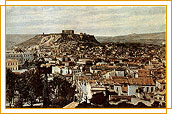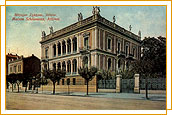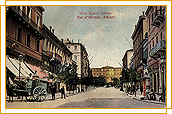Athens in the 19th century
In September 18th 1838, Athens was selected as
the capital of the Greek state. In the February of the same
year,  its residents celebrated this fact in the church of
St Georgios, the ancient temple at Thisio, which for a long
had been transformed into a Christian church. its residents celebrated this fact in the church of
St Georgios, the ancient temple at Thisio, which for a long
had been transformed into a Christian church.
Between 1838 and 1896 there was a serious effort to create the city-planning of Athens according to the modern city-planning requirements of the European cities. Celebrated Greek and European architects, engineers and artists were invited to work to this purpose. However, due to financial difficulties, these requirements were necessarily reduced, providing Athens with the unavoidable hybrid character of a European city in the region, shaped under foreign principles, selectively applied. Nevertheless, as the urban landscape developed in time, the elements that had been introduced became established and, in the 1890s, the Greek capital had assumed -even though to a small scale- the familiar look of a neoclassic city of the 19th century.
Population
During that period the population of Athens was approximately 10,000-12,000 people.  When Athens became the capital, many people moved into the city and the value of urban property rose dramatically. In 1850, the area between the Acropolis and Lycabettus Hill was already thickly built. In the population census of 1879, Athens had already reached a population of 63,374 people. When Athens became the capital, many people moved into the city and the value of urban property rose dramatically. In 1850, the area between the Acropolis and Lycabettus Hill was already thickly built. In the population census of 1879, Athens had already reached a population of 63,374 people.
Streets
This was the period of neoclassicism and for this reason the streets and squares of Athens were named after important figures of classical history. It is interesting to observe that they did not name streets after the people from the Byzantine period, or the fighters of the Greek revolution: Byzantium was not yet recognized as part of Greek history and the history of the Revolution was still very recent and much alive. Many roads took the name of important Athenian families during the Ottoman period.
Districts
The inhabited districts of that period were around the Acropolis and Plaka. One of the oldest districts was Psiri, near Monastiraki. It took its name after the island Psara, since most of its residents came from there. At its centre there was the Heroon Square (Square of the Heroes), named after the fighters of the 1821 revolution who used to meet there.
Other old districts were Neapolis, which became pretty soon the district of university students, and Exarchia, named after the merchant Exarchos, who opened a general store, which was quite large for that period.
In 1860, families of builders that had moved in Athens from Anafi, an island near Santorini,  to work in the construction of the Palace created the district called Anafiotica at the foothill of the Acropolis. to work in the construction of the Palace created the district called Anafiotica at the foothill of the Acropolis.
During the 19th century, the commercial centre of the city was defined by the two busiest streets, Ermou and Aiolou. The first large and luxurious private houses were built in the new avenues Academias, Panepistimiou and Stadiou. Soon the district of Kolonaki started to take shape.
Problems
As the public sector was limited by financial shortage, most
of the new constructions were carried out by the private sector,
mainly wealthy Greeks living abroad. Even though large constructions
changed the topography of Athens, the city had still to face
serious problems: there were no regular streets and dust was
still one of its most disturbing characteristics; there were
not enough gas lamps in the streets and electricity was not
established yet due to the strong reaction of the gas company.
On top of that, Athens suffered from lack of water supply
system and sewerage.
However, the fact that Athens was selected as the first city to organize the Olympic Games, led to a hasty execution of public works, such as large streets, bridges, lighting etc. The materialization of these works helped in the accommodation of the visitors that watched the events of the first Olympic Games.
Society
Athens in the 19th century reflected the transformations of Greek society. It proved to be an attraction for different groups of people. People of different origin and culture met in the same area and had to face the new political and economic conditions. The people of the Aegean islands, the farmers of Thessaly and the educated immigrants from Western Europe were forced to co-exist in Athens. Such a diverse population was the audience that watched the Olympic Games of 1896.
|
